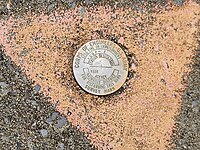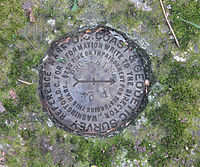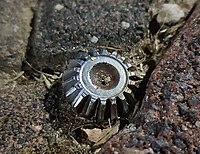Survey marker
The examples and perspective in this article may not represent a worldwide view of the subject. (September 2022) |





Survey markers, also called survey marks, survey monuments, or geodetic marks, are objects placed to mark key survey points on the Earth's surface. They are used in geodetic and land surveying. A benchmark is a type of survey marker that indicates elevation (vertical position). Horizontal position markers used for triangulation are also known as triangulation stations. Benchmarking is the hobby of "hunting" for these marks.
Types
[edit]All sorts of different objects, ranging from the familiar brass disks to liquor bottles, clay pots, and rock cairns, have been used over the years as survey markers.[1] Some markers have been used to designate tripoints, or the meeting points of three or more countries. In the 19th century, these marks were often drill holes in rock ledges, crosses or triangles chiseled in rock, or copper or brass bolts sunk into bedrock.
Today in the United States, the most common geodetic survey marks are cast metal disks with stamped legends on their face set in rock ledges, embedded in the tops of concrete pillars, or affixed to the tops of pipes that have been sunk into the ground. These marks are intended to be permanent, and disturbing them is generally prohibited by federal and state law.[2]
Survey markers in Nagoya, Japan, which bear stylized images of shachihoko, are noted for their elaborate design.[3]
History
[edit]Survey markers were often placed as part of triangulation surveys, measurement efforts that moved systematically across states or regions, establishing the angles and distances between various points. Such surveys laid the basis for map-making across the world.
Geodetic survey markers were often set in groups. For example, in triangulation surveys, the primary point identified was called the triangulation station, or the "main station". It was often marked by a "station disk" (see upper photo at left), a brass disk with a triangle inscribed on its surface and an impressed mark that indicated the precise point over which a surveyor's plumb-bob should be dropped to assure a precise location over it. A triangulation station was often surrounded by several (usually three) reference marks (see second photo at left),[4] each of which bore an arrow that pointed back towards the main station. These reference marks made it easier for later visitors to "recover" (or re-find) the primary ("station") mark. Reference marks also made it possible to replace (or reset) a station mark that had been disturbed or destroyed.
Some old station marks were buried several feet down (to protect them from being struck by ploughs). Occasionally, these buried marks had surface marks set directly above them.[5]
Database
[edit]In the U.S., survey marks that meet certain standards for accuracy are part of a national database that is maintained by the National Geodetic Survey (NGS), the successor agency to the United States Coast and Geodetic Survey (USC&GS). Each station mark in the database has a PID (Permanent IDentifier), a unique 6-character code that can be used to call up a datasheet describing that station.[6] The NGS has a web-based form[7] that can be used to access any datasheet, if the station's PID is known. Alternatively, datasheets can be called up by station name.[8]
A typical datasheet has either the precise or the estimated coordinates. Precise coordinates are called "adjusted" and result from precise surveys. Estimated coordinates are termed "scaled" and have usually been set by locating the point on a map and reading off its latitude and longitude. Scaled coordinates can be as much as several thousand feet distant from the true positions of their marks. In the U.S., some survey markers have the latitude and longitude of the station mark, a listing of any reference marks (with their distance and bearing from the station mark), and a narrative (which is updated over the years) describing other reference features (e.g., buildings, roadways, trees, or fire hydrants) and the distance and/or direction of these features from the marks, and giving a history of past efforts to recover (or re-find) these marks (including any resets of the marks, or evidence of their damage or destruction).
Current best practice for stability of new survey markers is to use a punch mark stamped in the top of a metal rod driven deep into the ground, surrounded by a grease filled sleeve, and covered with a hinged cap set in concrete.[9]
Survey markers are now often used to set up a GPS receiver antenna in a known position for use in Differential GPS surveying.[10]
In Brazil, a similar database is operated by the Brazilian Institute of Geography and Statistics.[11]
See also
[edit]- Benchmark (surveying), a surveying mark used as a reference point in measuring altitudes
- Boundary marker
- Milestone
- Triangulation station, a surveying mark used for horizontal positioning
Notes
[edit]- ^ For a comprehensive history of these marks in the United States, together with photos of all of the key variations, see the PDF of the article by CDR George E. Leigh, NOAA Corps (Ret’d.).
- ^ "18 U.S. Code § 1858 - Survey marks destroyed or removed". United States.
Whoever willfully destroys, defaces, changes, or removes to another place any section corner, quarter-section corner, or meander post, on any Government line of survey, or willfully cuts down any witness tree or any tree blazed to mark the line of a Government survey, or willfully defaces, changes, or removes any monument or bench mark of any Government survey, shall be fined under this title or imprisoned
- ^ "Survey markers and road ledger markers in Nagoya". Archived from the original on 2020-02-20. Retrieved 2017-06-25.
- ^ These marks were often set at roughly equal (120-degree) intervals from each other and were numbered in ascending order moving clockwise around the main station.
- ^ Here Archived 2012-02-24 at the Wayback Machine is an account of recovering (re-finding) a buried station mark from 1890 for which the surface mark had been destroyed. This account also describes the use of reference marks to locate station marks.
- ^ Here is a sample datasheet that describes a triangulation station with three reference marks. Distances and directions from the station to these reference marks are given in the outlined box on the datasheet. Originally there were a number of references to surrounding structures, but these structures were all later reported as destroyed. A later visitor then provided some new references.
- ^ The NGS datasheet-from-PID form is located here.
- ^ Here is the NGS web-based form for getting a datasheet for a station with a known name.
- ^ NOAA - National Oceanic and Atmospheric Administration[permanent dead link]
- ^ In the U.S., even though surveys carried out primarily by GPS are becoming more common, the network of physical survey markers continues to provide an important check on the accuracy of GPS-based methods, and one that is not dependent on satellites orbiting the Earth.
- ^ "BDG".
External links
[edit]No website will allow for searching of USGS Marks. Going to this link will allow you to download *DSWorld to search for NGS PID's in a variety of methods, and imports the marks directly into google earth for fast and easy visual searching of NGS Marks.
- NGS Survey Data Explorer is an interactive map that will find markers in a selected location. Marker types identified. Marker links to data sheet.
- This website provides a state-by-state mapping of NGS survey marks on to Google Maps, enabling one to search for these marks visually.
- Description and history of the types of markers used in the United States.
